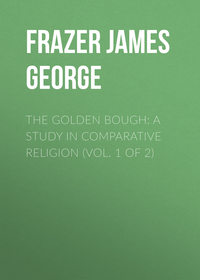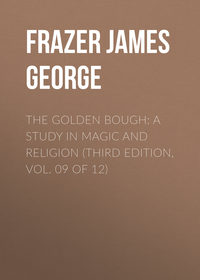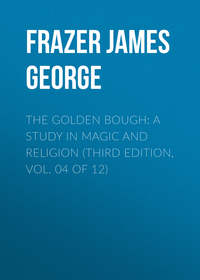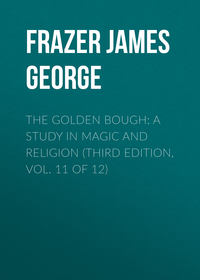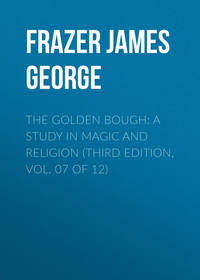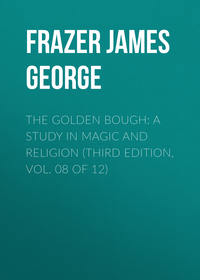
The Belief in Immortality and the Worship of the Dead, Volume 2 (of 3)
793
W. Ellis, op. cit. i. 395 sq.
794
See above, p. 49.
795
J. A. Moerenhout, op. cit. i. 538 sq.
796
J. A. Moerenhout, op. cit. i. 539-541. Compare W. Ellis, op. cit. i. 363 sqq.
797
J. A. Moerenhout, op. cit. i. 543.
798
J. Wilson, op. cit. p. 345.
799
J. Wilson, op. cit. p. 404.
800
W. Ellis, op. cit. i. 396.
801
W. Ellis, op. cit. i. 398 sq.
802
W. Ellis, Polynesian Researches, i. 407-409; J. Wilson, op. cit. p. 352; J. A. Moerenhout, op. cit. i. 546 sq.
803
J. A. Moerenhout, op. cit. i. 551 sq.
804
J. Cook, Voyages, i. 135, 218; J. R. Forster, Observations made during a Voyage round the World, p. 560.
805
W. Ellis, op. cit. i. 410.
806
J. Cook, Voyages, i. 218; J. R. Forster, Observations made during a Voyage round the World, p. 560.
807
J. Wilson, op. cit. pp. 352 sq.
808
J. Cook, Voyages, i. 218 sq.
809
W. Ellis, op. cit. i. 410; J. Wilson, op. cit. pp. 196, 362.
810
See Folk-lore in the Old Testament, ii. 82 sqq.
811
W. Ellis, op. cit. i. 406.
812
W. Ellis, op. cit. i. 401-403. Compare J. A. Moerenhout, op. cit. i. 552.
813
W. Ellis, op. cit. i. 412 sq. Compare J. Cook, Voyages, i. 135 sq., 138, 219; J. A. Moerenhout, op. cit. i. 547-549.
814
G. Forster, Voyage round the World, ii. 74. For the full description of the garb, see id., ii. 71-75; J. R. Forster, Observations made during a Voyage round the World, pp. 450-453.
815
J. Cook, Voyages, i. 138 sq., 219; J. R. Forster, Observations made during a Voyage round the World, pp. 560 sq.; W. Ellis, op. cit. i. 413 sq.; J. A. Moerenhout, op. cit. i. 549 sq. According to Ellis, the mummers were supposed to be inspired by the spirit of the deceased; according to Moerenhout, they were not inspired by, but merely represented, the ghost. The difference between spiritual representation and inspiration is somewhat fine; too fine perhaps to be apprehended by Tahitian intelligence. Forster says that the procession started from the house of the deceased, Ellis that it started from a valley.
816
D. Tyerman and G. Bennet, Journal of Voyages and Travels, i. 322.
817
W. Ellis, op. cit. i. 399 sq.
818
J. A. Moerenhout, op. cit. i. 553 sq.
819
W. Ellis, op. cit. i. 400.
820
W. Ellis, op. cit. i. 404.
821
J. Cook, Voyages, i. 93 sq., 135, 217, 218; J. Wilson, op. cit. pp. 84, 212 sq.; W. Ellis, op. cit. i. 404; J. A. Moerenhout, op. cit. i. 547.
822
J. Cook, op. cit. i. 217 sq. Compare J. R. Forster, Observations made during a Voyage round the World, p. 559.
823
J. Cook, Voyages, i. 93 sq., 135 sq., 218, 219, vi. 47 sq.; J. R. Forster, Observations made during a Voyage round the World, pp. 561 sq.; J. Wilson, op. cit. pp. 212 sq., 363 sq.; W. Ellis, op. cit. i. 400 sq., 404 sq., 405 sq.; J. A. Moerenhout, op. cit. i. 554.
824
W. Ellis, op. cit. i. 272, who observes that the survivors "considered the spirits of the proprietors of these skulls as the guardian spirits of the family."
825
W. Ellis, op. cit. i. 405.
826
A. Baessler, Neue Südsee-Bilder (Berlin, 1900), pp. 37 sq., 81 sq., 83.
827
J. Wilson, op. cit. p. 364.
828
W. Ellis, op. cit. i. 403.
829
J. Wilson, op. cit. p. 363.
830
See above, p. 305.
831
W. Ellis, op. cit. i. 403.
832
J. Wilson, op. cit. p. 364.
833
J. Cook, Voyages, i. 222, vi. 150.
834
J. Wilson, op. cit. p. 345.
835
J. R. Forster, Observations made during a Voyage round the World, pp. 552, 553; G. Forster, Voyage round the World, ii. 151 sq.
836
J. R. Forster and G. Forster, ll.cc.
837
W. Ellis, Polynesian Researches, i. 348, "the unus, or curiously carved pieces of wood marking the sacred places of interment, and emblematical of tiis or spirits."
838
G. Forster, op. cit. i. 267. Compare J. A. Moerenhout, op. cit. i. 461, "Les images des Tiis étaient placées aux extrémités des marais et gardaient l'enceinte des terres sacrées."
839
J. R. Forster, op. cit. pp. 544 sq. In the southern peninsula of Tahiti, both on the coast and inland, Captain Cook saw many sepulchral buildings, and he described them as "decorated with many carved boards, which were set upright, and on the top of which were various figures of birds and men: on one in particular there was the representation of a cock, which was painted red and yellow, to imitate the feathers of that animal, and rude images of men were, in some of them, placed one upon the head of another." See J. Cook, Voyages, i. 150 sq. These "carved boards" were no doubt of the same sort as the tees or teehees described by the two Forsters. No other writer seems to mention the figures of birds carved on them.
840
J. R. Forster, op. cit. p. 543.
841
W. Ellis, op. cit. i. 396. Compare J. Wilson, op. cit. p. 346; J. A. Moerenhout, op. cit. i. 431; D. Tyerman and G. Bennet, op. cit. i. 330.
842
W. Ellis, op. cit. i. 396 sq.; J. A. Moerenhout, op. cit. i. 433.
843
D. Tyerman and G. Bennet, Journal of Voyages and Travels, i. 273; compare ib. pp. 330 sq.
844
D. Tyerman and G. Bennet, op. cit. i. 521 sq.
845
J. Cook, Voyages, vi. 150.
846
J. Wilson, op. cit. pp. 345 sq.
847
J. Cook, Voyages, vi. 150 sq.
848
See above, pp. 87 sq., 214 sqq., 238 sqq.
849
D. Tyerman and G. Bennet, op. cit. i. 537 sq.
850
D. Tyerman and G. Bennet, op. cit. i. 331 sq.
851
D. Tyerman and G. Bennet, op. cit. i. 522.
852
J. A. Moerenhout, op. cit. i. 455.
853
J. Cook, i. 222. Compare id., vi. 150; J. R. Forster, Observations made on a Voyage round the World, pp. 553 sqq.
854
W. Ellis, op. cit. i. 397. Compare J. A. Moerenhout, op. cit. i. 433.
855
See above, p. 317.
856
W. Ellis, op. cit. i. 245 sq., 397; J. A. Moerenhout, op. cit. i. 434 sq.
857
J. Williams, Narrative of Missionary Enterprises in the South Sea Islands, p. 476.
858
J. R. Forster, Observations made during a Voyage round the World, p. 553; G. Forster, Voyage round the World, ii. 151.
859
See above, pp. 299 sqq.
860
J. Cook, Voyages, vi. 152.
861
A. Baessler, Neue Südsee-Bilder, p. 37.
862
A. Baessler, op. cit. pp. 83 sq.
863
A. Baessler, op. cit. pp. 81 sq.
864
J. Wilson, op. cit. p. 344.
865
T. Wilson, op. cit. p. 343.
866
J. Wilson, op. cit. p. 345. "The general name for deity, in all its ramifications, is eatooa" (id. p. 343).
867
J. Wilson, p. 346.
868
In confirmation of my conjecture that the missionaries mistook a general name (tee, otherwise spelled tii) for the name of a particular demon, I may point out that the naturalist J. R. Forster before them seems to have fallen into precisely the same mistake with regard to another general name for departed spirits (oramatuas or oromatuas). Thus he writes: "Besides these divinities of the second class, there are others of a still inferior rank, and though called Eatooas, are no more than what the Greek or Roman mythologists would have called Genii, or Dii minorum gentium: one of them, called Orometooa, is of a malignant disposition, resides chiefly near the Marais and Toopapous (places of burial) and in or near the boxes, or little chests, including the heads of their deceased friends, each of which, on that account, is called Te-wharre no te Orometooa, the house of the evil genius Orometooa, The people at Taheitee are of opinion, that if their priests invoke this evil genius, he will kill, by a sudden death, the person on whom they intend to bring down the vengeance of this divinity." See J. R. Forster, Observations made during a Voyage round the World, pp. 541 sq. In this passage we can hardly doubt that "this evil genius," Orometooa, is simply the oramatuas or oromatuas, the spirits of the dead, by means of whom sorcerers were supposed to injure or destroy any one at whom they or their employers had a grudge. See above, p. 299, and below, pp. 323 sqq.
869
W. Ellis, Polynesian Researches. i. 334-336.
870
W. Ellis, op. cit. i. 337.
871
W. Ellis, op. cit. i. 363.
872
W. Ellis, op. cit. i. 363-370.
873
W. Ellis, op. cit. iii. 112, 125.
874
J. Williams, Narrative of Missionary Enterprises in the South Sea Islands, pp. 466 sq.
875
D. Tyerman and G. Bennet, op. cit. i. 254 sq. As to Hiro, the god of thieves, see also J. A. Moerenhout, op. cit. i. 447-449.
876
W. Ellis, Polynesian Researches, i. 351 sq. Compare J. A. Moerenhout, op. cit. i. 502 note1, 523.
877
Captain J. Cook, Voyages, iii. 274 sqq.; G. Forster, Voyage round the World, ii. 5 sqq.; C. P. Claret Fleurieu, Voyage round the World performed by E. Marchand (London, 1801), i. 27 sqq., 55 sqq.; J. Wilson, Missionary Voyage to the Southern Pacific Ocean, pp. lxxiii. sqq., 127 sqq.; A. J. von Krusenstern, Voyage round the World (London, 1813), i. 136; Vincendon-Dumoulin et C. Desgraz, Îles Marquises ou Nouka-hiva (Paris, 1843), pp. 1 sqq., 12 sq.; Le P. Mathias G – , Lettres sur les Îles Marquises (Paris, 1843), pp. 7 sqq.; P. E. Eyriaud des Vergnes, L'Archipel des Iles Marquises (Paris, 1877), pp. 1 sqq.; C. E. Meinicke, Die Inseln des Stillen Oceans, ii. 235 sq.; F. H. H. Guillemard, Australasia, ii. 522.
878
As to the formation and scenery of the islands, see Krusenstern, op. cit. i. 110; C. S. Stewart, Visit to the South Seas (London, 1832), i. 193 sqq.; F. D. Bennett, Narrative of a Whaling Voyage round the Globe (London, 1840), i. 299 sqq.; H. Melville, Typee, pp. 8 sq., 17 sq., and passim (Everyman's Library); Vincendon-Dumoulin et C. Desgraz, op. cit. pp. 138 sq.; P. E. Eyriaud des Vergnes, op. cit. pp. 84 sq.; Clavel, Les Marquisiens (Paris, 1885) pp. 1 sq.; C. E. Meinicke, op. cit. ii. 236 sq.; F. H. H. Guillemard, op. cit. pp. 522 sq.; A. Baessler, Neue Südsee-Bilder (Berlin, 1900), pp. 192 sq., 220 sqq. As to the extreme difficulty of scaling the mountains and precipices to pass from one valley to another, see particularly M. Radiguet, Les Derniers Sauvages (Paris, 1882), pp. 101 sq., note.
879
Captain David Porter, Journal of a Cruise made to the Pacific Ocean, Second Edition (New York, 1822), ii. 86 sqq.
880
H. Melville, Typee (London, Everyman's Library, no date). The first edition of this book was published in 1846. Melville's residence among the Taipiis (Typees) fell in the year 1841.
881
P. E. Eyriaud des Vergnes, op. cit. p. 85.
882
M. Radiguet, Les Derniers Sauvages (Paris, 1882), pp. 304 sq.; P. E. Eyriaud des Vergnes, op. cit. p. 57.
883
Mathias G – , op. cit. p. 94.
884
P. E. Eyriaud des Vergnes, op. cit. p. 57. Compare M. Radiguet, Les Derniers Sauvages, pp. 304 sq.
885
H. Melville, Typee, p. 220.
886
A. Baessler, op. cit. pp. 222 sq.
887
M. Radiguet, op. cit. p. 304.
888
J. Cook, Voyages, iii. 284.
889
G. Forster, Voyage round the World, ii. 14 sq. Compare Krusenstern, op. cit. i. 152 sq.; U. Lisiansky, Voyage round the World (London, 1814), p. 85; G. H. von Langsdorff, Reise um die Welt (Frankfurt am Mayn, 1812), i. 92 sqq.; Fleurieu, op. cit. i. 96 sqq.; Vincendon-Dumoulin et C. Desgraz, op. cit. pp. 216 sqq.; Eyriaud des Vergnes, op. cit. p. 39.
890
H. Melville, Typee, p. 194.
891
H. Melville, Typee, p. 195.
892
David Porter, op. cit. ii. 58 sq.
893
F. D. Bennett, op. cit. i. 304.
894
M. Radiguet, op. cit. p. 169.
895
Eyriaud des Vergnes, op. cit. p. 39.
896
Eyriaud des Vergnes, op. cit. pp. 39 sq.; H. Melville, Typee, p. 195.
897
C. S. Stewart, Visit to the South Seas, i. 231 sq., who speaks highly of the beauty of the women. But the general opinion appears to be that the Marquesan women are much less handsome than the men. See Langsdorff, op. cit. i. 94-96; Porter, op. cit. ii. 59.
898
F. D. Bennett, op. cit. i. 308 sq.
899
Eyriaud des Vergnes, op. cit. pp. 42-44; Clavel, Les Marquisiens, pp. 3 sqq. Compare G. Forster, op. cit. ii. 27 sq.; Langsdorff, op. cit. i. 106-108; Fleurieu, op. cit. i. 115 sq.; Porter, op. cit. ii. 50-55; F. D. Bennett, op. cit. i. 316 sq.; H. Melville, Typee, pp. 120-124, 179; Vincendon-Dumoulin et C. Desgraz, op. cit. pp. 277 sq.; Mathias G – , op. cit. pp. 138 sq., 144 sq.; A. Baessler, op. cit. pp. 208-211. As to the preparation and drinking of kava among the Marquesans, see also M. Radiguet, op. cit. pp. 64-66.
900
Krusenstern, op. cit. i. 164; Porter, op. cit. ii. 53; C. S. Stewart, op. cit. i. 213 sq.; F. D. Bennett, op. cit. i. 345 (who says that the only root the natives cultivate for food is the sweet potato); Mathias G – , op. cit. pp. 148, 149; Clavel, op. cit. p. 18.
901
Fleurieu, op. cit. i. 122 sq.; Porter, op. cit. ii. 116; Bennett, op. cit. i. 337 sq.; Melville, Typee, pp. 158-160, 210; Mathias G – , op. cit. pp. 137 sq.; Radiguet, op. cit. pp. 53 sq.; Eyriaud des Vergnes, op. cit. 55 sq.; Clavel, op. cit. 19.
902
Krusenstern, op. cit. i. 164.
903
Fleurieu, op. cit. i. 118 sq.; Krusenstern, op. cit. i. 162; Lisiansky, op. cit. p. 88; Langsdorff, op. cit. i. 152 (bows and arrows unknown); Vincendon-Dumoulin et C. Desgraz, op. cit. pp. 282 sq.
904
Fleurieu, op. cit. i. 121; Krusenstern, op. cit. i. 162.
905
H. Melville, Typee, pp. 118 sq.; Clavel, Les Marquisiens, pp. 11 sq. Compare G. Forster, op. cit. ii. 20; D. Porter, op. cit. ii. 116; Mathias G – , op. cit. p. 143.
906
J. Cook, Voyages, iii. 285 sq.; G. Forster, op. cit. pp. 21, 24; J. Wilson, op. cit. pp. 131, 134 sq.; Lisiansky, op. cit. p. 84; Krusenstern, op. cit. i. 159; Langsdorff, op. cit. i. 109-111; Porter, op. cit. ii. 39 sq.; C. S. Stewart, op. cit. i. 209-211, 212, 267 sq.; Bennett, op. cit. i. 302 sq.; Melville, Typee, pp. 81-83; Vincendon-Dumoulin et C. Desgraz, op. cit. pp. 274-276; Mathias G – , op. cit. pp. 122-129; Radiguet, op. cit. pp. 36-38; Eyriaud des Vergnes, op. cit. pp. 44 sq.; Clavel, op. cit. pp. 15 sq.; Baessler, op. cit. pp. 200-208.
907
Langsdorff, op. cit. i. 109 sq.
908
Mathias G – , op. cit. p. 129.
909
Langsdorff, l. c.
910
Clavel, op. cit. p. 15.
911
F. D. Bennett, op. cit. i. 303 sq.; Baessler, op. cit. pp. 207 sq.
912
J. Cook, Voyages, iii. 287; Krusenstern, op. cit. i. 163 sq.; Langsdorff, op. cit. i. 150; Porter, op. cit., ii. 12-14; Bennett, op. cit. i. 338; Vincendon-Dumoulin et C. Desgraz, op. cit. pp. 280-282.
913
Krusenstern, op. cit. i. 163.
914
C. S. Stewart, op. cit. i. 317.
915
Melville, Typee, pp. 203 sq.
916
Clavel, op. cit. p. 60.
917
Radiguet, op. cit. 173.
918
Mathias G – , op. cit. p. 111.
919
Lisiansky, op. cit. p. 83. As to polyandry in the Marquesas, see further E. Westermarck, History of Human Marriage, Fifth Edition (London, 1921), iii. 146 sqq.
920
Eyriaud des Vergnes, op. cit. pp. 19 sq.; Clavel, op. cit. pp. 56, 61 sq.
921
Radiguet, op. cit. pp. 16 sq., 158 sq.; Clavel, op. cit. pp. 61 sq.
922
Fleurieu, op. cit. i. 119 sq., 124; Langsdorff, op. cit. i. 146; Porter, op. cit. ii. 124-126; Vincendon-Dumoulin et C. Desgraz, op. cit. p. 284; Mathias G – , op. cit. p. 96. As for the ability of the natives to swim in the sea for hours without fatigue, compare J. Wilson, Missionary Voyage to the Southern Pacific Ocean, p. 129.
923
C. S. Stewart, op. cit. i. 214 sq.
924
C. S. Stewart, op. cit. i. 233 sq. Compare Vincendon-Dumoulin et C. Desgraz, op. cit. pp. 265 sq.
925
Langsdorff, op. cit. i. 138.
926
Radiguet, op. cit. p. 195.
927
C. S. Stewart, op. cit. i. 236 sq.; F. D. Bennett, op. cit. i. 318; Vincendon-Dumoulin et C. Desgraz, op. cit. pp. 264 sq.; Mathias G – , op. cit. pp. 69 sqq.; Radiguet, op. cit. pp. 192 sq.
928
Langsdorff, op. cit. i. 138.
929
Vincendon-Dumoulin et C. Desgraz, op. cit. p. 231. Compare C. S. Stewart, op. cit. i. 237, who calls the performers Kaioi.
930
See above, pp. 259 sqq.
931
C. S. Stewart, op. cit. i. 234, 236, 237.
932
Porter, op. cit. ii. 38 sq.; F. D. Bennett, op. cit. i. 317 sq.; Mathias G – , op. cit. pp. 54-56; Melville, Typee pp. 93-95. Of these writers it is Porter who gives the dimensions of some of the blocks of stone composing the platforms and expresses his amazement at the labour involved in their construction. He concludes his description as follows (ii. 39): "When we count the immense numbers of such places, which are everywhere to be met with, our astonishment is raised to the highest, that a people in a state of nature, unassisted by any of those artificial means, which so much assist and facilitate the labour of the civilized man, could have conceived and executed a work, which, to every beholder, must appear stupendous. These piles are raised with views to magnificence alone; there does not appear to be the slightest utility attending them: the houses situated on them are unoccupied, except during the period of feasting, and they appear to belong to a public, without the whole efforts of which they could not have been raised, and with every exertion that could possibly have been made, years must have been requisite for the completion of them." Of one of these structures seen by him in the anterior of Nukahiva, Stewart observes, "The stones, bearing marks of antiquity that threw the air of an old family mansion around the whole, were regularly hewn and joined with the greatest nicety, many which I measured being from four to six feet in length, nearly as wide, and two or more deep" (Visit to the South Seas, i. 267 sq.).


